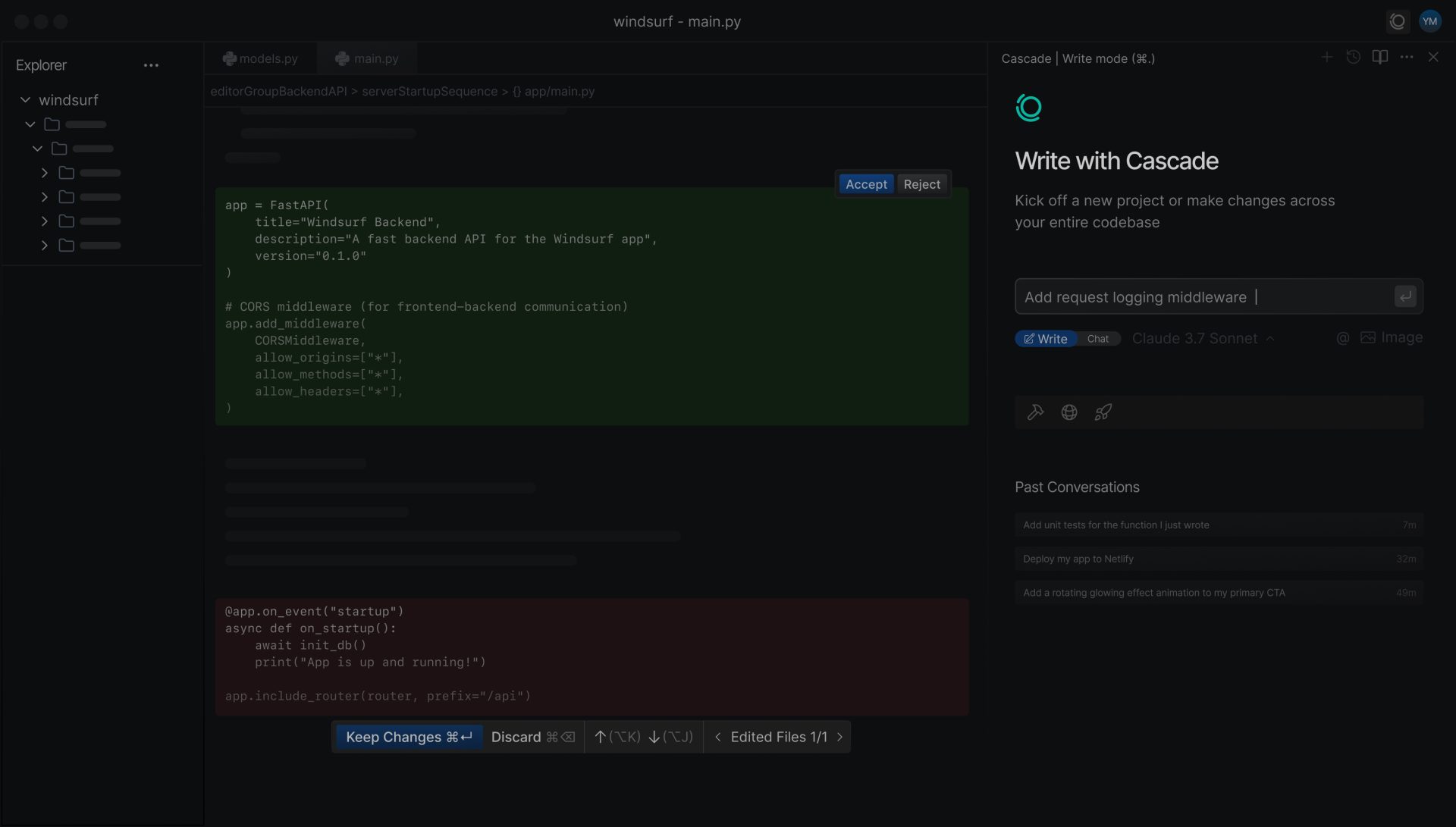Key Takeaways
What is Windsurf AI? An advanced AI-powered code editor built on VS Code that helps developers write, debug, and deploy code through intelligent features that anticipate needs and streamline workflows.
- 🚀 Exceptional terminal command handling with automatic error recovery and retry capabilities
- 💻 Unique “Cascade” agent provides visible step-by-step workflow automation for code tasks
- ⚠️ Significant performance slowdowns when working with larger codebases
- 🔄 Clear separation between “Write” mode (modifies files) and “Chat” mode (provides assistance)
- 🔒 Strong privacy controls including optional zero-data retention for sensitive projects
- 💸 Credit-based pricing system limits usage even on paid plans ($15/month for Pro)
- 🌐 Compatible with most VS Code extensions but filters some based on performance
This review covers: features, integrations, customization, performance, pricing, pros and cons, and real-world use cases.
What is Windsurf AI?
Windsurf AI (formerly known as Codeium) is an AI-powered integrated development environment that builds upon VS Code’s foundation while adding intelligent features like predictive coding, automated error detection, and integrated deployment capabilities.
Use Cases
🛠️ When does Windsurf AI shine? It excels in several development workflows:
- 💡 Rapid Prototyping: Quickly build proof-of-concept applications with AI anticipating needs and automating repetitive tasks
- 🔄 Code Refactoring: Identify and implement improvements to existing codebases with context-aware understanding
- 🐛 Bug Fixing: Detect errors and suggest solutions, even running terminal commands to resolve issues
- 🏗️ Full-Stack Development: Support for both frontend and backend with smart context-switching between components
- 🚀 Automated Deployment: Preview, build, and deploy applications without leaving the IDE
- 📚 Knowledge Expansion: Get contextual suggestions when working with unfamiliar frameworks or languages
- ⌨️ Terminal Operations: Streamline command-line workflows with intelligent terminal handling
Getting Started and Ease of Use
🔍 How’s the installation experience? Windsurf offers straightforward setup with a familiar VS Code-based layout, making it accessible to developers already comfortable with Microsoft’s editor.
🤖 What about the AI assistant? The Cascade agent introduces itself during onboarding as an AI assistant ready to help with coding tasks, with intuitive toggle between “Write” and “Chat” modes that separates code generation from conversational assistance.
⚠️ Learning curve challenges? Some users report a brief adjustment period when adapting to Windsurf’s hotkeys and command patterns, which differ slightly from standard VS Code.
🛑 Workflow interruptions? When Windsurf is analyzing or generating code, developers must sometimes wait without being able to continue working, which can disrupt productivity.
AI Features and Code Generation
💻 How does the Cascade agent work? It serves as the primary interface for code generation, allowing developers to describe needs in natural language and receive executable code in response.
🔍 How’s the code quality? Generation quality varies based on project complexity and instruction specificity. For smaller, well-defined tasks, Windsurf often produces accurate code requiring minimal adjustment, but larger projects may need more refinement.
💡 Standout Feature: Step-by-step approach to code generation that analyzes problems, identifies necessary files, creates or modifies them, and executes terminal commands to implement solutions
🛠️ Error handling capabilities? Windsurf can detect issues with generated code and attempt automatic fixes. When terminal commands fail, the system recognizes problems and suggests alternatives without developer intervention.
⚠️ Generation limitations? Some users note that code generation sometimes adheres too closely to existing patterns, potentially limiting creativity: “Code generally seems to be a better result when I’m using Cloud directly versus using this tool.”
Customization and User Control
🧩 Extension compatibility? Windsurf maintains compatibility with most popular VS Code extensions, though it filters some based on performance benchmarks.
🧠 What is the “Memories” feature? This allows Windsurf to retain important details about your codebase and workflow patterns, creating a personalized experience that improves over time.
🎮 Control over AI actions? The Write/Chat toggle provides clear control over whether AI suggestions modify files, while TurboMode lets developers determine if terminal commands execute automatically or require approval.
⚠️ Permission inconsistencies? Some users report unpredictable behavior with permission settings, noting it sometimes “asks for permission to run scripts other times it seems to just go wild and create a bunch of stuff.”
📊 Context management limitations? Some users find context handling less robust than competitors: “adding contexts just feels pretty boring and uninspired. There isn’t a preview and it doesn’t have as many nice features as Cursor.”
🔌 Integration flexibility? MCP (Multiple Context Protocol) support allows developers to connect custom tools and services to enhance AI workflows, extending functionality beyond built-in features.
Performance, Speed, and Reliability
⚡ How fast is it for typical projects? For small to medium-sized projects, users report responsive behavior with quick code generation and prompt autocompletions.
🐢 Performance bottlenecks? Response speed degrades significantly with larger files and complex codebases: “It seems like it can run pretty quickly until you’ve got these big files. Then it seems to really take forever.”
⏳ Workflow impact? When the AI is working, developers report difficulty continuing with other tasks: “I can’t work while it’s working. When I do try and keep myself busy and make edits during that time, there’s a diff which actually derails its ability.”
🖥️ System resource usage? The editor is engineered to be lean, particularly on Linux systems, with a smaller memory footprint than standard VS Code installations.
💡 Terminal Excellence: Terminal command execution stands out as “the best terminal command runner I’ve used to date” with strong error recovery capabilities
⚠️ Context management concerns? When working with multiple projects simultaneously, some users worry that “if you weren’t specific, it may mingle the two” contexts.
Collaboration and Team Features
👥 How well does it support teams? Windsurf includes several features for team environments, though capabilities appear more oriented toward enterprise usage than direct real-time collaboration.
💰 Team pricing? The Teams tier ($35 per user/month) provides pooled credit access and team-specific features including analytics, indexing, and the Forge AI code reviewer.
⚠️ Collaboration limitations? The editor lacks some common real-time collaboration features found in other development environments, focusing instead on individual workflow enhancement.
🏢 Enterprise benefits? Enterprise customers receive additional tools including audit logs and analytics APIs that provide insights into team productivity and code quality.
🚀 Onboarding impact? Windsurf claims to decrease onboarding time by 4-9x through AI-assisted code explanation and automated guidance for team members navigating unfamiliar codebases.
Integrations with Other Tools
🧩 VS Code extension support? Windsurf maintains strong compatibility with most popular extensions while applying performance filters to ensure responsiveness.
🔌 What is MCP Support? The Multiple Context Protocol feature enhances integration flexibility, allowing connection with custom tools and services.
🔗 Built-in integrations? Windsurf provides curated MCP servers for one-click setup with popular tools:
- 🐙 GitHub for version control integration
- 🗄️ PostgreSQL and Neon for database connections
- 🎭 Playwright for testing automation
- 🎨 Figma for design asset integration
- 💬 Slack for communication
🖌️ Design workflow support? The editor supports drag-and-drop image functionality, enabling quick implementation of designs by dropping images directly into the Cascade chat.
🛠️ JetBrains compatibility? Windsurf offers Cascade integration into JetBrains IDEs, bringing AI capabilities to environments like IntelliJ IDEA, PyCharm, and WebStorm.
💡 Terminal Excellence: Command suggestions and execution capabilities streamline development workflows, with ability to analyze output, suggest fixes, and execute subsequent commands
Pricing and Plan Options
💲 What are the pricing tiers? Windsurf uses a credit-based pricing structure with free and paid options:
- 🆓 Free Plan: Limited access to Cascade, Windsurf Editor, plugins, and basic AI features. Includes one-time trial allocation of 50 User Prompt credits and 200 Flow Action credits
- 💵 Pro Plan ($15/month): 500 User Prompt credits and 1,500 Flow Action credits, priority access to advanced models, higher context limits, faster tab speed
- ⭐ Pro Ultimate ($60/month): Unlimited User Prompt credits, 3,000 Flow Action credits, plus priority support
- 👥 Teams ($35 per user/month): 300 User Prompt/1,200 Flow Action credits per user with pooled access, plus team analytics and Forge AI code reviewer
- 🏆 Teams Ultimate ($90 per user/month): 2,500 Flow Action credits and unlimited User Prompt credits per user
- 🏢 Enterprise SaaS: Custom pricing with on-premises options, private fine-tuning, audit logs, and analytics API
🔄 How do credits work? Credits limit usage even on paid plans, with additional credits available for $10 per 300 credits on Pro plans and above. Unused credits roll over between billing periods.
💰 Competitive positioning? Windsurf’s Pro plan is priced higher than GitHub Copilot ($10/month) but offers broader AI-powered features. Power users may need more expensive tiers for uninterrupted usage due to credit limitations.
Data Privacy, Security, and Trust
🔒 How does Windsurf handle sensitive code? The platform emphasizes privacy with user-controlled protections including optional zero-day data retention and encryption for data in transit.
🤖 AI training concerns? Unlike some competitors, Windsurf claims to avoid training on non-permissive data, addressing concerns about proprietary code being used without consent.
🏢 Enterprise security? Enhanced features for enterprise customers include audit logs and compliance-focused capabilities, with on-premises or hybrid deployment options for strict governance requirements.
⚙️ Privacy controls? The Pro plan includes optional zero data retention, ensuring code isn’t stored beyond the immediate processing required for AI assistance.
⚠️ Verification limitations? Available information doesn’t include details about specific compliance certifications or third-party security audits that would provide additional verification.
Customer Support and Learning Resources
🆘 Support availability? Windsurf provides several support channels, with higher-tier subscriptions receiving priority assistance in a tiered approach.
🏢 Enterprise support options? Enterprise customers receive additional support including guided implementation workshops that address organization-specific challenges and adoption best practices.
👥 Community resources? A Discord community is available for users seeking peer assistance, though detailed information about documentation quality is limited.
📰 Update information? Windsurf maintains a blog with release announcements and capability explanations to help users stay current with platform developments.
⚠️ Support limitations? Limited information about direct support channels makes response times or support quality difficult to evaluate comprehensively.
Summary
- 🔑 Windsurf AI excels at terminal operations and step-by-step code generation, but struggles with larger files and complex projects
- ⚙️ The credit-based pricing system creates usage limitations even on paid plans that may restrict heavy users
- 💡 Best suited for developers who need intelligent assistance with moderate-sized projects and value privacy controls
- ✅ VS Code foundation provides familiarity and extension compatibility that reduces learning curves
- ❌ Workflow interruptions during AI processing represent a significant productivity challenge
- ✅ Exceptional terminal command handling with intelligent error recovery
- ✅ Step-by-step Cascade agent workflow explains AI processes transparently
- ✅ Clear Write/Chat toggle prevents accidental file modifications
- ✅ Familiar VS Code interface reduces learning curve
- ✅ Flexible MCP integration with external tools and services
- ✅ Strong privacy controls protect sensitive development data
- ✅ Memory feature provides increasingly relevant assistance over time
- ❌ Significant slowdowns when working with larger codebases
- ❌ Can’t continue working while AI is processing code
- ❌ Credit limitations restrict usage even on paid plans
- ❌ Limited context visualization compared to competitors
- ❌ Slight learning curve for hotkeys and command patterns
- ❌ Inconsistent permission handling sometimes acts without confirmation
- ❌ Focuses more on individual productivity than collaboration
Frequently Asked Questions
How does Windsurf AI differ from GitHub Copilot?
Windsurf AI offers a more comprehensive development environment compared to GitHub Copilot’s focus on inline code suggestions. While both use AI to assist with code generation, Windsurf provides additional features like terminal command execution, integrated deployment, and the ability to make multi-file changes through its Cascade agent. Pricing differs as well, with Windsurf’s Pro plan at $15/month compared to Copilot’s $10/month subscription, though Windsurf uses a credit-based system with specific usage limits.
What limitations does the free version of Windsurf have?
The free version of Windsurf provides limited access to the Cascade agent, Windsurf Editor, plugins, and basic AI features. It includes a one-time allocation of 50 User Prompt credits and 200 Flow Action credits, but doesn’t allow purchasing additional premium credits. Free users can’t access premium models at full speed and face restrictions on context length and indexing capabilities compared to paid plans.
Can Windsurf AI handle large codebases effectively?
Windsurf AI shows variable performance with large codebases. While it offers features for analyzing and understanding project structure, users report significant slowdowns when working with larger files. As one user noted, “It seems like it can run pretty quickly until you’ve got these big files. Then it seems to really take forever.” Projects with moderate complexity generally perform better than extensive, multi-component applications.
Does Windsurf AI work with multiple programming languages?
Yes, Windsurf AI supports multiple programming languages, providing code suggestions and assistance across different development environments. The system can adapt to various languages and frameworks, though specific performance may vary by language. The AI uses context awareness to understand language-specific patterns and requirements, adjusting its suggestions accordingly.
How does the credit system work in Windsurf AI’s paid plans?
Windsurf’s paid plans allocate specific numbers of User Prompt credits and Flow Action credits. User Prompt credits apply to interactions initiated by the developer, while Flow Action credits cover automated actions taken by the AI. The Pro plan ($15/month) includes 500 User Prompt credits and 1,500 Flow Action credits, with additional credits available for purchase at $10 per 300 credits. Unused credits roll over between billing periods, preventing immediate loss if not used.
Can I use my favorite VS Code extensions with Windsurf?
Most popular VS Code extensions work with Windsurf, though the platform filters extensions based on performance benchmarks to maintain responsiveness. This means some extensions might be unavailable if they don’t meet Windsurf’s performance requirements. Users report that essential development tools generally remain compatible, but specific niche extensions may not be supported.
How does Windsurf handle privacy and data security?
Windsurf emphasizes privacy with features like optional zero-day data retention, encryption for data in transit, and attribution filtering. The platform claims not to train on non-permissive data, addressing concerns about proprietary code being used for AI improvement without consent. Enterprise customers receive additional security features including audit logs and on-premises deployment options for stricter data governance requirements.
Ready to try Windsurf AI? Visit the official site



